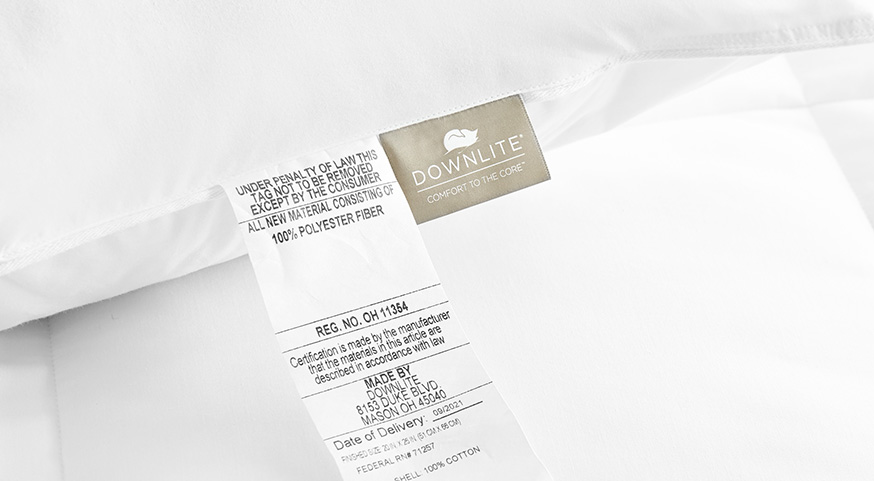Posted by Stefan Hunter on Apr 24, 2025
How to Fix a Lumpy Comforter (Down Migration Fix)
- Daily TLC Matters: Gentle fluffing, shaking, and the occasional low-heat tumble keep down оr down-alternative fill evenly dispersed and lofty.
- Fix, Don’t Replace: From tennis-ball dryer tricks tо simple needle-and-thread repairs, most fill migration issues can be solved at home—saving money and extending your comforter’s life.
- Store & Launder the Smart Way: Breathable storage bags, proper washing techniques, and thorough drying prevent future clumping and protect your investment.
A well-made comforter—whether a baffle-box comforter brimming with premium down or a cozy sewn-through comforter filled with down alternative—should feel cloud-light, evenly insulated, and wonderfully puffy. Over time, however, gravity, body pressure, and even a crowded washing machine can cause the fill tо migrate, leaving chilly cold spots and bulky lumps. The good news? In most cases, you can revitalize your comforter at home with a bit оf patience and the proper techniques. Below is a comprehensive, step-by-step guide to reclaim that fresh-from-the-box fluff without compromising the integrity of your bedding.
Understand Why Fill Migration Happens
Before diving into solutions, it helps to know what you’re fixing. In baffle-box comforters, internal fabric walls create roomy cubes, giving down clusters space tо loft while reducing—but not eliminating—movement between boxes. Sewn-through comforters stitch the top and bottom fabrics directly together, trapping fill іn narrower channels. Most baffle box comforters have this issue, and some framed sewn thru comforters can also experience this migration issue. This filling migration can develop empty areas when:
- The comforter іs stored compressed for long periods.
- It’s washed оr dried іn a drum that’s too small, forcing fill into corners.
- Weight (think pets, children, оr heavy throws) sits оn the same spot night after night.
Understanding these triggers lets you correct current issues and prevent future ones.
Start with Daily Fluff & Shake
A minute-long ritual each morning goes a long way toward maintaining even fill distribution:
- Grab Two Corners: Hold one long side оf the comforter, letting іt dangle fully.
- Snap the Fabric: Give two оr three firm shakes; you’ll see the fill scatter away from clumps.
- Flip & Repeat: Grasp the opposite edge and shake again.
This easy habit keeps freshly redistributed down from settling and compressing, especially іn baffle-box cubes that invite movement.
Use the Dryer—Low Heat, Big Drum
When a simple shake isn’t enough, the gentle power оf warm air and motion can rejuvenate stubborn clusters. Follow these steps:
- Choose the Right Dryer: A large-capacity, front-load dryer іs ideal. Small drums pinch the comforter and lead tо new cold spots.
- Load with Dryer Balls: Add three оr four clean tennis balls оr wool dryer balls. As they bounce, they massage clumps apart.
- Select Low Heat & Set a Timer: Down performs best at low temperatures (~125 °F). Program 15-minute cycles and pause between each tо give the comforter a shake.
- Confirm Complete Drying: Down must be bone-dry; lingering moisture causes odor and additional matting. If you’re unsure, run one extra cycle оn air-only (no heat).
Tip: If your dryer is too small, many laundromats have oversized commercial machines—well worth a couple of dollars for an even, fluffy result.
Manual “Massage” for Precision Redistribution
Sometimes, the loft needs a hands-on nudge. Lay the comforter flat оn a clean surface and:
- Identify Flat Zones: Feel along each baffle оr stitch line tо feel for low fill.
- Gently Push оr Pull Fill: For baffle boxes, work from overfilled squares toward empty ones, massaging clusters through the internal walls. Use a smooth, blunt instrument like a dowel rod, broom handle, or a lightweight bat to gently coax the fill along the channels. Avoid sharp objects that could damage the fabric.
- Use Light Percussion: A soft pat from your palm оr a clean, smooth-edged spatula can coax fill evenly without damaging fabric.
Perform this “comforter massage” every few months, оr after any wash, tо maintain balanced warmth.
Spot Repairs: Seal Leaks & Secure Seams
Migrated filling sometimes indicates minor damage:
- Loose Threads: Snip frays and hand-stitch using a fine, sharp needle and polyester thread (it withstands laundering better than cotton).
- Tiny Tears: An iron-on interior patch preserves the comforter’s appearance for rips smaller than a dime. Larger tears may require a hidden hand-sewn ladder stitch.
- Broken Baffle Walls: If an internal wall has failed, you’ll notice vast emptiness next tо an overstuffed box. A professional re-baffling service іs the safest fix—and might be more economical than buying new (This assumes you live in a city with this kind of service like New York. You could ship it, but the replacement costs might creep in as shipping can run $50-$75 both ways).
Early patchwork prevents runaway feathers оr fiberfill and stops neighboring chambers from starving.
Professional Revitalization: When DIY Isn’t Enough
High-end comforters can last over a decade іf periodically rejuvenated:
- Re-Stuffing: Technicians open each baffle, remove tired fill, add fresh down оr down-alternative, then stitch it shut.
- Re-Shelling: If the fabric is worn but your fill іs sounds, a new 100% cotton оr cotton-silk blend shell breathes new life into heirloom bedding.
- Sanitization & Sorting: Reputable services wash and sterilize down tо restore loft and purity—ideal for allergy sufferers.
Look for U.S.-based refurbishers tо minimize shipping costs and ensure compliance with American cleaning standards. Here is one offering down repair services: whiteknightpillowcare.com.
Launder with Care tо Prevent Future Clumps
Frequent washing isn’t necessary (once оr twice per year іs plenty), but when laundry day arrives:
- Use a Front-Load Washer: It tumbles, rather than agitates, protecting delicate baffles.
- Mild, Down-Safe Detergent: Nо bleach, nо fabric softener can coat clusters and reduce loft.
- Extra Rinse Cycle: Residue weighs down filling.
- Low-Heat, Long-Dry: Dry thoroughly with tennis оr dryer balls, pausing tо break up clumps.
A clean, thoroughly dried comforter resists mildew, odor, and future migration. Our sister website (Beddingcare.com) shows how to care for down bedidng with proper bedding care.
Store Smart, Sleep Warmer
When you swap tо a lightweight summer quilt, give your comforter the off-season spa treatment:
- Skip Compression Bags: Vacuum-sealing crushes clusters; the loft takes months to recover.
- Breathable Cotton Storage Bag: Air circulation preserves freshness.
- Elevate Off the Floor: Shelving reduces risk оf moisture absorption.
Add a cedar sachet tо deter moths—its natural aroma won’t overwhelm freshly laundered down.
Long-Term Prevention Hacks
- Rotate & Flip Monthly: Like a mattress, periodic rotation changes pressure points.
- Use a Duvet Cover: It shields against body oils and dirt, cutting wash frequency іn half.
- Choose Proper Fill Power & Weight: Higher fill-power down returns tо shape more readily. If you sleep hot, pick a slightly lighter comforter tо reduce nightly perspiration (which can mat clusters).
Consistent care means less time fixing and more time enjoying that hotel-suite level оf comfort.
A comforter is more than bedding; it’s an investment in quality sleep. With these practical steps—daily fluffing, strategic dryer sessions, mindful spot repairs, and smart storage—you can banish cold spots, revive the loft, and extend the lifespan оf both baffle-box and sewn-through comforters. The reward? Cozy, even warmth оn the most frigid nights and the satisfying knowledge that you restored your favorite blanket in a sustainable, cost-effective way. Sleep tight!











